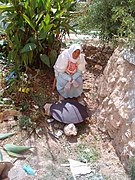Tava

This article needs additional citations for verification. (May 2020) |

A tava(h) / tawa(h) (mainly on the Indian subcontinent), saj (in Arabic), sac (in Turkish), and other variations and combinations thereof, [clarification needed] is a metal-made cooking utensil.[1] The tawa is round and can be flat, but more commonly has a curved profile, and while the concave side can be used as a wok or frying pan, the convex side is used for cooking flatbreads and pancakes.[1][2]
The Indian tawa might have a handle or not, and it can be made of cast iron or aluminium,[1] or of carbon steel.[3] The utensil may be enameled or given a non-stick surface.[4][5] The tawa and saj are used in the cuisines of South,[1] Central, and West Asia, as well as of the Caucasus and the Balkans. The tawa is also used in Indo-Caribbean cuisine.[6]
Names by region
[edit]Taaba, Tava, tawa
[edit]In Iran, the Persian word tāve (تاوه) is used[7] which is derived from the Persian word taaba which means something that is curved or tempered. The root word taab in Persian is a verb which means to bend or temper or curve (but see here-below for the use of saj in Iran). It is cognate with tawaa, a word which in nearly all Indo-Aryan languages such as Punjabi, Hindi and Urdu means cooking pan.[8] In Afghanistan, the curved cast-iron utensil used for cooking bread is known as tawah,[9] but in Pashto it is more popularly known as tabakhey (تبخے/طبخی).[citation needed] The Georgian cognate is tapa (ტაფა).[citation needed]
Saj, saç
[edit]Saj (صاج, lit. sheet-metal) is the equivalent of tava in Arabic,[10][11] with the equivalent saç or sac in Turkish, and is used in Southwest Asia.[9] In Iran, saj is used for the curved iron plate employed in cooking bread[9] (but see here-above for the use of tāve in Iran).
Variants, change of meaning
[edit]The word tava is also used in Turkish and all across the Balkans, and refers to any kind of frying pan.[citation needed][dubious – discuss] In Serbia and Bulgaria however, a тава (tava) is a metal baking tray with raised margins (for the meaning of sach in those same countries, see here-below).[citation needed] In Romanian too, tava can mean baking tray, such as employed for baking in an oven, but it can also mean tray, such as used for serving food and drink.[12]
The sač is a saj-shaped lid used as a cooking utensil in the Balkans. In Serbia and Bulgaria, the flat ceramic сач (sach) or сачѐ (sachè) is used for table-top cooking of thin slices of vegetables and meat[citation needed] (for the meaning of tava in those same countries, see here-above).
- Pita being baked on a convex saj
- Reversible Azerbaijani sac with handles
- Markouk being baked on a convex saj
Uses
[edit]A tava or saj is used to bake a variety of leavened and unleavened flatbreads and pancakes across the broad region: pita, naan, saj bread, roti, chapati, paratha, dosa, and pesarattu. In Pakistan, especially in rural areas, large convex saj are used to cook several breads at the same time or to make rumali roti.
- A Palestinian woman baking markook on a saj in a West Bank village
- A roti being baked on a tava
- Gözleme, a filled bread, being baked on a sac
- Manasir woman preparing qurasah (قراصة), the daily bread on Sherari Island in Dar al-Manasir in Northern Sudan
- Vegetables fried in a tawa
- Aloo chaat being cooked in a large tava
- Fish frying in a tawa
See also
[edit]- Comal (cookware), a similar utensil in Mexican cuisine
- Karahi, a similar utensil in Indian cuisine
- Wok, a similar utensil in East Asian cuisine
- Mittad
- Griddle, a flat cast iron used in frying
- Skillet, a frying pan with a long handle
- Mongolian barbecue, a Taiwanese grill dish sometimes using a saj-like frying pan
- List of cooking vessels
References
[edit]- ^ a b c d Petrina Verma Sarkar. "What Is an Indian Tawa?". The Spruce Eats. Retrieved 2019-10-02.
- ^ Fodor's Turkey. Fodor's Travel. 27 May 2014. ISBN 9780804141925.
- ^ "Tawa". Made In Cookware. Retrieved 2023-12-13.
- ^ Marie Simmons, Things Cooks Love: Implements, Ingredients, Recipes, 2008, ISBN 0740769766, p. 251
- ^ South Indian Cooking. Sanjay & Co. ISBN 9788189491796.
- ^ Mason, Taymer (2016). Caribbean Vegan: Meat-Free, Egg-Free, Dairy-Free Authentic Island Cuisine for Every Occasion. The Experiment. ISBN 9781615193615. Retrieved 2021-12-21.
- ^ F. Steingass, A Comprehensive Persian–English Dictionary, 1930, p. 277
- ^ "A dictionary of Urdu, classical Hindi, and English". Dsalsrv02.uchicago.edu. Archived from the original on 2021-01-08. Retrieved 2017-10-11.
- ^ a b c Joseph, Suad; Najmabadi, Afsaneh, eds. (2003). Encyclopedia of Women & Islamic Cultures. Vol. 3: Family, Body, Sexuality And Health. BRILL. p. 109. ISBN 9004128190. Retrieved 21 December 2021.
- ^ Maxime Rodinson, et al., Medieval Arab cookery, 2001, p. 154
- ^ Hans Wehr, Dictionary of Modern Written Arabic, 1966, p. 499
- ^ "tavă". dexonline.ro. Retrieved 22 Dec 2021.
Sources
[edit]- "Your Desi (Indian) Kitchen on the Net". Archived from the original on 2008-04-08. Retrieved 2008-04-01.
- "Pots, Pans, and Griddles". Archived from the original on 2008-10-14. Retrieved 2008-05-01.
- "A Fork on the Road". - Miami Herald online. Retrieved February 21, 2008.[dead link]
- "Saj Femmes". Blog: Land and People. 2007-09-23. Retrieved February 21, 2008.









